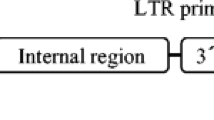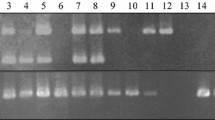Abstract
We have exploited the repetitive and dispersed nature of many long terminal repeat (LTR)-retrotransposon families for characterizing genome constitutions and classifying cultivars of the genusMusa. Insertional polymorphisms of the elements were studied using seven published and two newly designed primers facing outwards from the LTRs and reverse transcriptase (RT) domain of the retrotransposon. The primers generated specific amplification patterns showing the universal applicability of this marker type. The Inter-Retrotransposon Amplified Polymorphism (IRAP) markers distinguished the A and B genomes of the banana species (Musa acuminata Col la andMusa balbisiana Colla) and between banana cultivars. The IRAP markers enabled phylogenetic analysis of 16 Malaysian banana cultivars and determination of the genome constitution of hybrid banana (AAB, ABB, AABB, and AAAB), and gave information about ancestral genotypes of the hybrids. In addition, the IRAP detected new retrotransposon insertions into the genome of tissue culture regenerants. This PCR-based IRAP assay is amenable to large-scale throughput demands in screening breeding populations and is applicable for any crop.
Similar content being viewed by others
Literature Cited
Baumel A, Ainouche M, Kalendar R, Schulman AH (2002) Inter-retrotransposon amplified polymorphism (IRAP), and retotransposon-microsatellite amplified polymorphism (REMAP) in populations of the young allopolyploid speciesSpartina angelica Hubbard (Poaceae). Mol Biol Evol 19: 1218–1227
Boyko E, Kalendar R, Korzun V, Gill B, Schulman AH (2002) Combined mapping ofAegilops tauschii by ret-rotransposon, microsatellite, and gene markers. Plant Mol Biol 48: 767–790
Flavell AJ, Dunbar E, Anderson R, Pearce SR, Hartley R, Kumar A (1992)Tyl-copia group retrotransposons are ubiquitous and heterogeneous in higher plants. Nucl Acids Res 20: 3639–3644
Flavell AJ, Knox MR, Pearce SR, Ellis THN (1998) Ret-rotransposon-based insertion polymorphisms (RBIP) for high throughput marker analysis. Plant J 16: 643–650
Grandbastien M-A, Spielmann A, Caboche M (1989)Tnt1, a mobile retroviral-like transposable element of tobacco isolated by plant cell genetics. Nature 337: 376–380
Hirochika H (1993) Activation of tobacco retrotransposons during tissue culture. EMBO J 12: 2521–2528
Hirochika H, Sugimoto K, Otsuki Y, Tsugawa H, Kanda M (1996) Retrotransposons of rice involved in mutations induced by tissue culture. Proc Natl Acad Sci USA 93: 7783–7788
Horry JP, Ortiz R, Arnaud E, Crouch JH, Ferris RSB, Jones DR, Mateo N, Picq C, Vuylsteke (1997) Banana and plantain.In D Fuccillo, L Sears, P Stapleton, eds, Biodiversity in Trust. (Conservation and Use of Plane Genetic Resources in CGIAR Centres), Cambridge University, London, pp 67–81
Iwamoto M, Nagashima H, Nagamine T, Higo T, Higo K (1999)p-SINE1-like intron of theCatA catalase homologs and phylogenetic relationships among AA-genomeOryza and related species. Theor Appl Genet 98: 853–861
Kalendar R, Grab T, Regina M, Suoniemi A, Schulman AH (1999) IRAP and REMAP: Two new retrotransposon-based DNA fingerprinting techniques. Theor Appl Genet 98: 704–711
Kalendar R, Tanskanen J, Immonen S, Nevo E, Schulman AH (2000) Genome evolution of wild barley (Hordeum spontaneum) byBARE-1 retrotransposon dynamics in response to sharp microclimatic divergence. Proc Natl Acad Sci USA 97: 6603–6607
Kumar A, Bennetzen J (1999) Plant retrotransposons. Ann Rev Genet 33: 479–532
Manninen O, Kalendar R, Robinson J, Schulman AH (2000) Application ofBARE-1 retrotransposon markers to the mapping of a major resistance gene for net blotch in barley. Mol Gen Genet 264: 325–334
Nakayashiki H, Ikeda K, Hashimota Y, Tosa Y, Mayama S (2001) Methylation is not the main force repressing the retrotransposon MAGGY inMagnaporthe grisea. Nucl Acids Res 29: 1278–1284
Pearce SR, Harrison G, Li D, Heslop-Harrison JS, Kumar A, Flavell AJ (1996) TheTy1-copia group of retrotrans-posons inVicia species: Copy number, sequence heterogeneity and chromosomal localisation. Mol Gen Genet 205: 305–315
Pearce SR, Knox M, Ellis THN, Flavell AJ, Kumar A (2000) Pea Ty1-copia group retrotransposons: transpositional activity and use as markers to study genetic diversity inPisum. Mol Gen Genet 263: 898–907
Pearce SR, Stuart-Rogers C, Knox MR, Kumar A, Ellis THN, Flavell AJ (1999) Rapid isolation of plant Ty1-copia group retrotransposon LTR sequences for molecular marker studies. Plant J 19: 711–717
Saitou N, Nei M (1987) The neighbor-joining method: a new method for reconstructing phylogenetic trees. Mol Biol Evol 4: 406–425
SanMiguel P, Tikhonov A, Jin YK, Motchoulskaia N, Zakharov D, Melake-Berhan A, Springer PS, Edwards KJ, Lee M, Avramova Z, Bennetzen JL (1996) Nested retrotransposons in the intergenic regions of the maize genome. Science 274: 765–768
Shimamura M, Yasue H, Ohshima K, Abe H, Kato H, Kishiro T, Goto M, Munechika I, Okada N (1997) Molecular evidence from retroposons that whales form a clade within even-toed ungulates. Nature 388: 666–670
Shirasu K, Schulman AH, Lahaye T, Schulze-Lefert P (2000) A contiguous 66 kb barley DNA sequence provides evidence for reversible genome expansion. Genome Res 10: 908–915
Stover P, Simmonds NW (1987) Bananas, Ed 3. Longman, London
Tatout C, Warwick S, Lenoir A, Deragon JM (1999) Sine insertions as clade markers for wildCrucifer species. Mol Biol Evol 16: 1614–1621
Teo CH, Tan SH, Othman YR, Schwarzacher T (2002) The cloning of Ty1-copia-like retrotransposons from 10 varieties of banana (Musa sp.). J Biochem Mol Biol Biophys 6: 193–201
Vicient CM, Jaaskelainen M, Kalendar R, Schulman AH (2001) Active retrotransposons are a common feature of grass genomes. Plant Physiol 125: 1283–1292
Vicient CM, Schulman AH (2002) Copia-like retrotransposons in the rice genome: few and assorted. Genome Lett 1: 35–47
Voytas DF, Cummings MP, Konieczny AK, Ausubel FM, Rodermel SR (1992) Copia-like retrotransposons are ubiquitous among plants. Proc Natl Acad Sci USA 89: 7124–7128
Waugh R, McLean K, Flavell AJ, Pearce SR, Kumar A, Thomas BBT, Powell W (1997) Genetic distribution ofBARE-1-like retrotransposable elements in the barley genome revealed by sequence-specific amplification polymorphisms (S-SAP). Mol Gen Genet 253: 687–694
Author information
Authors and Affiliations
Corresponding author
Rights and permissions
About this article
Cite this article
Teo, C.H., Tan, S.H., Ho, C.L. et al. Genome constitution and classification using retrotransposon-based markers in the orphan crop banana. J. Plant Biol. 48, 96–105 (2005). https://doi.org/10.1007/BF03030568
Received:
Accepted:
Issue Date:
DOI: https://doi.org/10.1007/BF03030568




